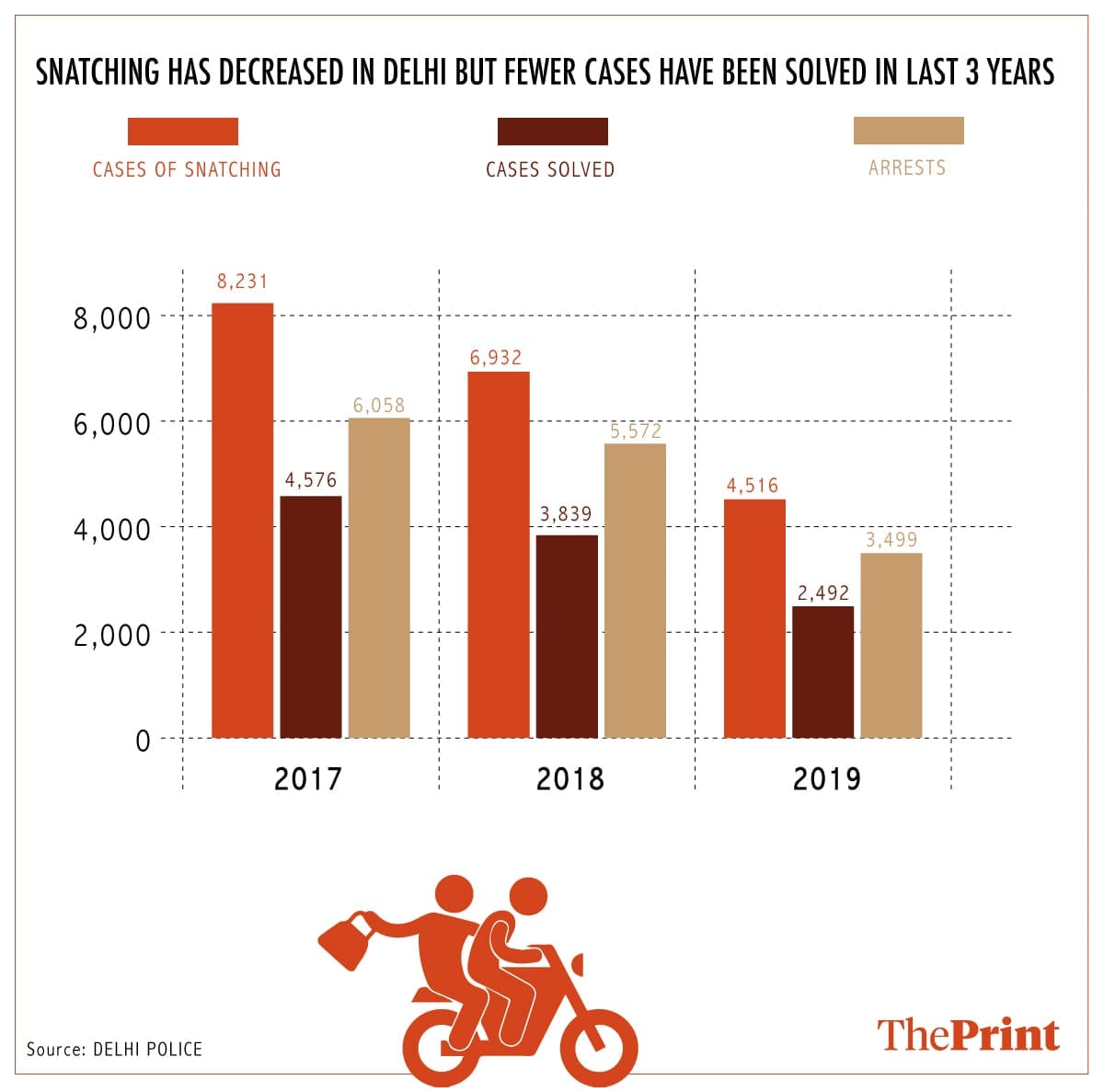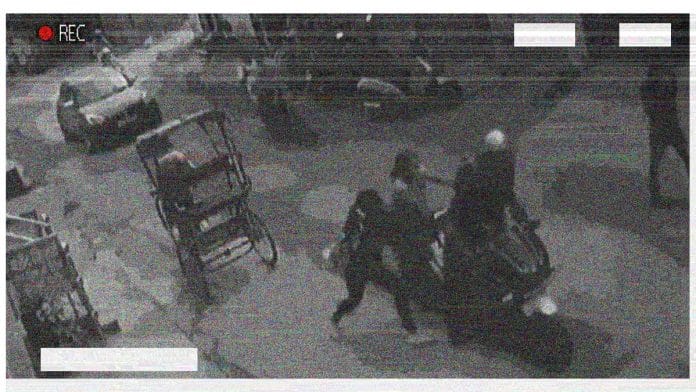New Delhi: For the last few weeks, Delhi has seen a sharp rise in the number of snatching incidents — leading to panic among residents.
Last week, a journalist working with a news agency became a victim of one such incident. Joymala Bagchi, an ANI journalist, was dragged out of a moving auto-rickshaw and robbed of her phone in a crowded market in south Delhi’s C.R. Park area. She suffered serious injuries and had to be admitted to AIIMS.
A few days later, snatchers targeted another journalist in Okhla. The woman identified as Radhika was talking on phone when two men on a bike came from behind and snatched her phone.
Between January and September, an average of 500 incidents of snatching have taken in the national capital every month.
The Delhi Police, in a report published last week, however claimed a 29 per cent reduction in the number of such cases since 2017.
The numbers, however, fail to give confidence to the people of Delhi, with snatching cases being reported every day.
And notably, it is not just common people who have been targeted by snatchers, but even VIPs have been at the receiving end.
On 24 June, Shobha Gupta, wife of Leader of the Opposition in Delhi Assembly Vijendra Gupta, became the target of snatchers who stole her bag in Mandi House area.
Besides snatching, incidents of burglary have also created fear among residents. On 22 September, burglars broke into Delhi Home Minister Satyendra Jain’s residence in Saraswati Vihar. The minister had even tweeted about it.
Law and order in the national capital is managed by the Delhi Police, which comes under the jurisdiction of the Union Ministry of Home Affairs. And every time a crime takes place, political mudslinging begins between the Aam Aadmi Party-ruled Delhi government and the BJP-led central dispensation.

Also read: Delhi Police asked to pursue Arun Jaitley phone surveillance case with ‘all sincerity’
From January to September, over 500 snatching incidents per month
According to the Delhi Police report released last week, as many as 6,466 incidents of snatching took place in 2017 until September. The corresponding figures for September 2018 and 2019 are 4,707 and 4,516, respectively. This means, from January to September this year, Delhi on an average saw at least 501 cases of snatching every month, and half of these remain unresolved.
Speaking about this, Deputy Commissioner of Police (Central Zone) Mandeep Singh Randhawa told ThePrint, “Delhi is connected with several states via porous borders. Criminals easily manage to flee to other states and because of this, a number of cases remain unresolved.”
The DCP, however, claimed that Delhi’s record in solving snatching cases was much better than any other metro city in the world.
“The main items stolen during snatching are gold chains and mobiles. Snatchers sell the gold chains to jewellers and they melt it as soon as possible. In this process, the evidence gets eliminated,” said senior police officer, who did not wish to be named.
The officer said even stolen phones could not be traced as the snatchers would sell them in Nepal or Bangladesh, after changing their IMEI (International Mobile Equipment Identity) numbers that is crucial to track a mobile phone.
The police report also mentions that 95 per cent of those involved in snatching are first-time offenders.
Asked about the report, a former Delhi commissioner of police, who did not wish to be named, told ThePrint that such crime data was not always credible.
He added: “In the case of (excess) FIRs being registered in any specific police station, everyone starts putting pressure on the SHO (station house officer) and he is promptly transferred.”
“The easiest way for police to deal with crime is to not register a case, and this phenomenon is not limited to Delhi but can be seen in any part of the country,” said the former top cop.
Also read: Delhi Police will soon launch website & app to file missing persons report online
‘Snatching should be made non-bailable offence’
In 2017, Delhi’s Lieutenant Governor Anil Baijal and then home minister Rajnath Singh had launched Yuva scheme, aimed to wean vulnerable youngsters away from crime and train them in job-oriented courses.
The Delhi Police claims to have since taken steps such as setting up of anti-snatching squads at every police station and identifying vulnerable spots, among others, to reduce the menace of snatching.
Citing the recent implementation of stringent traffic laws under the new Motor Vehicles Act, the former Delhi police chief quoted above said strict laws might help curb street crimes.
He, however, added: “There is no alternative to conventional honest policing. The most stringent laws and state-of-art techniques can never achieve what can be accomplished by hard groundwork by police personnel.”
According to another Delhi Police officer, they keep a record of repeated offenders and kingpins of criminal gangs. “Their activities can be tracked by tracking their phones, which will help police keep a check on crimes,” he said.
Speaking to ThePrint, Delhi Police’s public prosecutor Richa Kapoor said, “Two things need to be proven beyond the ambit of doubt. First, the identity of the criminal involved and second, the identification of the stolen item.”
Criminal lawyer Ajay Kumar Verma, who has also been a victim of phone-snatching, said criminals involved in such incidents easily get bail, and, therefore, there is no fear of law. He said snatching should be made a non-bailable offence and treated under IPC sections 394 and 392 that deal with offenses like robbery.
Also read: For 5 yrs, Delhi Police didn’t act on cop who shot dead biker. But a mom wouldn’t let go







Case hi register nahi karte, drop toh hoga hi